
The Studenica Monastery, pronounced [mânastiːr studɛ̌nit͡sa]) is a 12th-century Serbian Orthodox monastery situated 39 kilometres (24 mi) southwest of Kraljevo and 40.9 kilometres (25.4 mi) east of Ivanjica, in central Serbia. It is one of the largest and richest Serb Orthodox monasteries.

The Boyana Church is a medieval Bulgarian Orthodox church situated on the outskirts of Sofia, the capital of Bulgaria, in the Boyana quarter. In 1979, the building was added to the UNESCO World Heritage List.
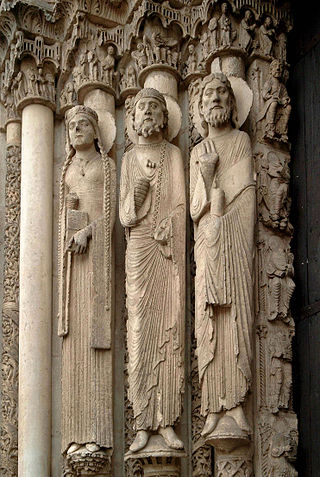
Gothic art was a style of medieval art that developed in Northern France out of Romanesque art in the 12th century AD, led by the concurrent development of Gothic architecture. It spread to all of Western Europe, and much of Northern, Southern and Central Europe, never quite effacing more classical styles in Italy. In the late 14th century, the sophisticated court style of International Gothic developed, which continued to evolve until the late 15th century. In many areas, especially Germany, Late Gothic art continued well into the 16th century, before being subsumed into Renaissance art. Primary media in the Gothic period included sculpture, panel painting, stained glass, fresco and illuminated manuscripts. The easily recognizable shifts in architecture from Romanesque to Gothic, and Gothic to Renaissance styles, are typically used to define the periods in art in all media, although in many ways figurative art developed at a different pace.

The Palazzo Vecchio is the town hall of Florence, Italy. It overlooks the Piazza della Signoria, which holds a copy of Michelangelo's David statue, and the gallery of statues in the adjacent Loggia dei Lanzi.

The Basilica of Saint Francis of Assisi is the mother church of the Roman Catholic Order of Friars Minor Conventual in Assisi, a town in the Umbria region in central Italy, where Saint Francis was born and died. It is a Papal minor basilica and one of the most important places of Christian pilgrimage in Italy. With its accompanying friary, Sacro Convento, the basilica is a distinctive landmark to those approaching Assisi. It has been a UNESCO World Heritage Site since 2000.

Hagia Sophia is a formerly Greek Orthodox church which was converted into a mosque in 1584, and located in Trabzon, in the north-eastern part of Turkey. It was converted into a museum in 1964 and back into a mosque in 2013. It dates back to the thirteenth century when Trabzon was the capital of the Empire of Trebizond. It is located near the seashore and two miles west of the medieval town's limits. It is one of a few dozen Byzantine sites extant in the area. It has been described as being "regarded as one of the finest examples of Byzantine architecture."

Vardzia is a cave monastery site in southern Georgia, excavated from the slopes of the Erusheti Mountain on the left bank of the Kura River, thirty kilometres from Aspindza. The main period of construction was the second half of the twelfth century. The caves stretch along the cliff for some five hundred meters and in up to nineteen tiers. The monastery was an important cultural center, a place of significant literary and artistic work.
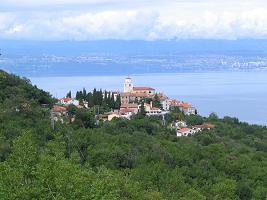
Mošćenice is a village in the municipality of Mošćenička Draga in Primorje-Gorski Kotar County on the Istrian peninsula, close to Opatija, Croatia.
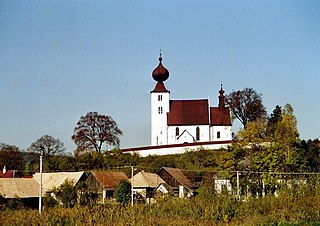
Žehra is a village and municipality in the Spišská Nová Ves District in the Košice Region of central-eastern Slovakia.
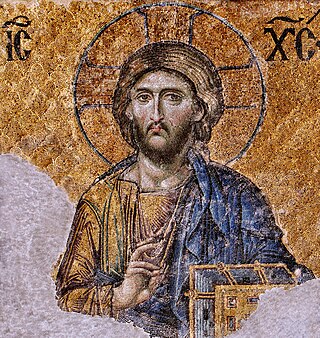
Göreme is a district of the Nevşehir Province in Turkey. After the eruption of Mount Erciyes about 2.6 million years ago, ash and lava formed soft rocks in the Cappadocia Region, covering a region of about 20,000 square kilometres (7,700 sq mi). The softer rock was eroded by wind and water, leaving the hard cap rock on top of pillars, forming the present-day fairy chimneys. People of Göreme, at the heart of the Cappadocia Region, realized that these soft rocks could be easily carved out to form houses, churches, and monasteries. These Christian sanctuaries contain many examples of Byzantine art from the post-iconoclastic period. These frescos are a unique artistic achievement from this period.
Croatian art describes the visual arts in Croatia, and art by Croatian artists from prehistoric times to the present. In Early Middle Ages, Croatia was an important centre for art and architecture in south eastern Europe. There were many Croatian artists during the Medieval period, and the arts flourished during the Renaissance. Later styles in Croatia included Baroque and Rococo.
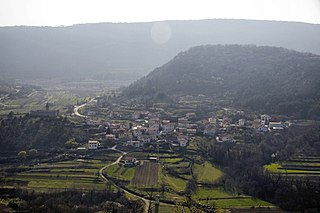
Hrastovlje is a village in the City Municipality of Koper in the Littoral region of Slovenia.

Gravisi–Barbabianca Mansion is a Baroque mansion in Koper, a port town in southwestern Slovenia. It was built in 1710. It was the family seat of the Gravisi family, who held the title of the Marquis of Pietrapelosa. Today it is the home of a music school.
Belmond Hotel Caruso is a hotel located in the hill town of Ravello, near Amalfi in southern Italy.

Holy Trinity Church is a historical building in Hrastovlje, a village in southwestern Slovenia. There are two hypotheses about its origin. According to the first, it is a Romanesque church from the 12th century. According to the second, it is an example of the Istrian variant of Early Venetian Renaissance architecture from the 15th century.

Keldby Church, famous for its frescoes, is located on the main road to Møns Klint in the village of Keldby, 4 km east of Stege on the Danish island of Møn.

The Oratorio di San Protaso is a church in via Lorenteggio, Milan, Lombardy.

The Bartolini Salimbeni Chapel is a chapel in the church of Santa Trinita, Florence, central Italy. Its decoration by Lorenzo Monaco, dating to the 1420s, are one of the few surviving examples of International Gothic frescoes in Italy. The chapel has kept other original elements, such as its altarpiece, an Annunciation, also by Monaco, and the railings.

The Holy Spirit Cathedral is a cathedral in Minsk, Belarus. Consecrated in honour of the Holy Spirit, it the mother church of the Belarusian Orthodox Church. It was built between 1633 and 1642 as a part Bernardine monastery during the Polish–Lithuanian Commonwealth in a place of former male Orthodox monasteries. The site became Orthodox again in 1860. The cathedral is listed as a Belarusian Cultural heritage object and is considered one of the main landmarks in Minsk Upper city.
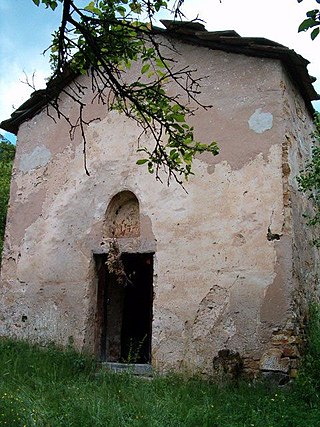
The Church of St Peter or Church of Saints Peter and Paul is a small medieval Bulgarian Orthodox church located in the village of Berende in Dragoman Municipality, Sofia Province, in westernmost Bulgaria. Most likely constructed and decorated in the 14th century, the Church of St Peter features simple stone architecture but contains a number of remarkable interior frescoes.



















